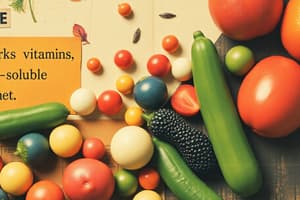Podcast
Questions and Answers
What is the primary natural form of Vitamin A?
What is the primary natural form of Vitamin A?
- Beta-carotene
- Retinol (correct)
- Cryptoxanthin
- Carotenoids
Which vitamin's absorption is primarily facilitated by sunlight exposure?
Which vitamin's absorption is primarily facilitated by sunlight exposure?
- Vitamin A
- Vitamin D2
- Vitamin E
- Vitamin D3 (correct)
Which condition is NOT associated with Vitamin A deficiency?
Which condition is NOT associated with Vitamin A deficiency?
- Hyperkeratosis
- Xerophthalmia
- Osteoporosis (correct)
- Nyctalopia
Which of the following is a source of Vitamin D3?
Which of the following is a source of Vitamin D3?
What enzyme is involved in the conversion of beta-carotene to retinal?
What enzyme is involved in the conversion of beta-carotene to retinal?
Which of the following physiological functions is NOT attributed to Vitamin A?
Which of the following physiological functions is NOT attributed to Vitamin A?
In which organ is Vitamin A primarily stored in the body?
In which organ is Vitamin A primarily stored in the body?
Which of these carotenoids can be converted into Vitamin A?
Which of these carotenoids can be converted into Vitamin A?
Which condition is a result of excessive Vitamin A intake?
Which condition is a result of excessive Vitamin A intake?
What is the role of Vitamin D in the body?
What is the role of Vitamin D in the body?
Which of the following statements about vitamins is true?
Which of the following statements about vitamins is true?
What is characteristic of fat-soluble vitamins?
What is characteristic of fat-soluble vitamins?
Which vitamin class includes vitamins that are not stored in the body?
Which vitamin class includes vitamins that are not stored in the body?
What can lead to a deficiency state of fat-soluble vitamins?
What can lead to a deficiency state of fat-soluble vitamins?
Which food sources are rich in vitamins?
Which food sources are rich in vitamins?
In what scenario can vitamins be considered drugs?
In what scenario can vitamins be considered drugs?
What defines vitamins as necessary nutrients?
What defines vitamins as necessary nutrients?
Which of the following represents a common deficiency symptom for vitamins?
Which of the following represents a common deficiency symptom for vitamins?
Which vitamin is known to primarily prevent beriberi?
Which vitamin is known to primarily prevent beriberi?
What differentiates synthetic vitamins from natural ones?
What differentiates synthetic vitamins from natural ones?
What is the primary role of vitamin D in the intestine?
What is the primary role of vitamin D in the intestine?
Which vitamin is primarily responsible for protecting cell membranes from oxidation?
Which vitamin is primarily responsible for protecting cell membranes from oxidation?
A deficiency in which vitamin can lead to rickets in children?
A deficiency in which vitamin can lead to rickets in children?
What is a common dietary source of vitamin E?
What is a common dietary source of vitamin E?
What cellular function is vitamin D NOT responsible for?
What cellular function is vitamin D NOT responsible for?
Which form of vitamin K is primarily found in green leafy vegetables?
Which form of vitamin K is primarily found in green leafy vegetables?
What is a consequence of vitamin E deficiency?
What is a consequence of vitamin E deficiency?
How is vitamin D3 formed in the skin?
How is vitamin D3 formed in the skin?
Which statement about vitamin K is correct?
Which statement about vitamin K is correct?
Which vitamin deficiency is linked to conditions like multiple sclerosis and diabetes?
Which vitamin deficiency is linked to conditions like multiple sclerosis and diabetes?
Flashcards
Vitamins
Vitamins
Organic substances required for metabolic functions, not synthesized by the body.
Fat-soluble Vitamins
Fat-soluble Vitamins
Vitamins soluble in fats; Vitamins A, D, E, and K. Stored in the body, so excessive intake can be toxic.
Water-soluble Vitamins
Water-soluble Vitamins
Vitamins soluble in water; Vitamin C and B complex. Not stored significantly; excess is excreted in urine.
Vitamin A (Retinol)
Vitamin A (Retinol)
Signup and view all the flashcards
Vitamin D (Ergocalciferol and Cholecalciferol)
Vitamin D (Ergocalciferol and Cholecalciferol)
Signup and view all the flashcards
Vitamin E (Tocopherol)
Vitamin E (Tocopherol)
Signup and view all the flashcards
Vitamin K (Naphthoquinone)
Vitamin K (Naphthoquinone)
Signup and view all the flashcards
Nyctalopia
Nyctalopia
Signup and view all the flashcards
Rickets
Rickets
Signup and view all the flashcards
Vitamin E function
Vitamin E function
Signup and view all the flashcards
Skin Hyperkeratosis
Skin Hyperkeratosis
Signup and view all the flashcards
Sunlight
Sunlight
Signup and view all the flashcards
Study Notes
Vitamins
- Organic substances essential for metabolic functions.
- Not synthesized within the body.
- Do not provide energy or serve as building blocks for cellular structure.
- Deficiency leads to specific conditions like beriberi, rickets, scurvy, and xerophthalmia.
Vitamin Classifications
- Fat-soluble vitamins: Vitamins A, D, E, and K
- Stored in the body.
- Deficiencies are less common, but excessive intake can be toxic.
- Water-soluble vitamins: Vitamin C and B complex
- Not stored significantly in the body.
- Excess is usually excreted in urine.
Fat-soluble Vitamins
- Vitamin A (Retinol):
- Essential for vision, growth, immune function, red blood cell formation, skin and bone health, and gene regulation.
- Sources: Fish liver oils, animal organs (heart, kidney, liver), plant carotenoids like beta-carotene in carrots and leafy greens.
- Deficiency can cause nyctalopia (night blindness), xerophthalmia, skin hyperkeratosis, growth retardation, and reduced infection resistance.
- Vitamin D (Ergocalciferol and Cholecalciferol):
- Essential for calcium absorption and utilization.
- Forms: Vitamin D3 (animal-sourced) and D2 (plant-sourced and fortified foods).
- Sources: Oily fish, fish oil, liver, egg yolk, butter, fortified foods, dietary supplements, and sunlight exposure.
- Functions: Calcium and phosphorus absorption, bone health, muscle and nerve contraction, immune function, general cellular health.
- Deficiency results in rickets in children and osteomalacia in adults.
- Vitamin E (Tocopherol):
- Major lipid-soluble antioxidant.
- Protects cell membranes, proteins, and DNA from oxidative damage.
- Sources: Plant oils, green vegetables, whole grains, egg yolks, and meats.
- Functions: Protects cell membranes, prevents lipid oxidation, supports blood vessel formation, boosts immune function.
- Deficiency leads to nerve and muscle damage, impaired movement control, muscle weakness, vision problems, and a weakened immune system.
- Vitamin K (Naphthoquinone):
- Forms: Phytonadione (K1), Menaquinone (K2), Menadione (K3), Menadiol (K4).
- Sources: Dairy products, fruits, vegetables, and especially green leafy vegetables.
- Important for blood clotting and bone health.
Studying That Suits You
Use AI to generate personalized quizzes and flashcards to suit your learning preferences.




